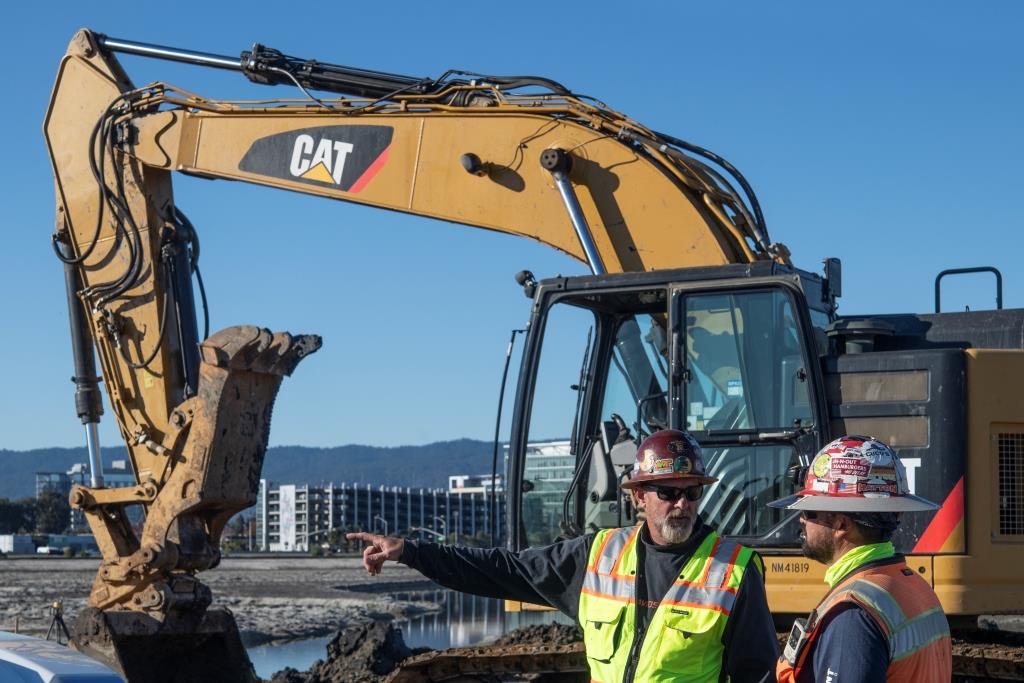And More Construction!
If you were one of the intrepid few who ventured over to Salty Dave’s Wetland Weblog a few weeks ago and read the piece about our Phase 2 project at the Island Ponds, you know how excited we are to be underway there.
But now, I have a question for you:
What’s better than having a project site in construction?
Having two project sites in construction!!!
That’s right, we are not only knee-deep in construction at the Alviso Island Ponds*, but we are also making progress at the Ravenswood Ponds in Menlo Park. You can have a look at this map of the project plan to get the overall picture, but here’s a list of the key elements of this extremely complicated Phase 2 project:
- Three different types of habitat restoration:
- Tidal marsh
- Seasonally dry managed ponds for threatened western snowy plovers
- Muted tidal managed ponds for waterfowl and shorebirds
- Raising existing levees to keep these habitat types separated and to provide flood management
- Two new sloping habitat transition zones between the tidal marsh and the adjacent uplands and levees (including planting by Save The Bay!**)
- A half-mile public trail with a viewing platform at its center; this trail will connect to the Bay Trail and to the existing trail network inside of the City of Menlo Park’s Bedwell Bayfront Park.
That may not sound so complex, but the devil is always in the details.
To enhance the two different types of managed ponds listed in that first bullet, we have to build and install four very large water control structures to allow the landowner, the Don Edwards San Francisco Bay National Wildlife Refuge, to move water in and out of those ponds as needed to achieve the project’s goals for habitats, water quality, and flood management. These water control structures are also called culverts***, and they have gates at both ends that can be opened and closed to control the timing, direction, and rate of flows through them. The construction crews have to dig trenches through the levees to create the space to place these culverts. Workers also have to build up the levee around the culverts, place rip rap (big chunks of rock) at the ends to avoid unintended erosion, and construct service walkways out to the controls so managers will be able to open or close the gates as needed.
And that’s just what we have going on this fall and winter. To even get to this point, for the last few years, we have been trucking in dirt from excavation projects around the region to build up levees and build those habitat transition zones. We’ve also been actively coordinating with the City of Menlo Park and other landowners (such as Cargill), government agencies and special districts (like One Shoreline****, the West Bay Sanitary District, and Caltrans) to make sure their own projects and infrastructure are protected and planned for. We are grateful for all of this collaboration with so many good project partners.
We’ll spend 2022 doing more earthwork inside and outside of the project area, completing the habitat transition zones, planting, and building the trail. And finally, we will breach the tidal marsh pond to the Bay and complete the work.
Lots to do still, but it’s important to note the progress being made. Getting these water control structures in place and completed is a critical step!
*For some of us, that is literally true, but I’m too proud to share details.
**Save The Bay’s important role in our project and many others is worthy of its own blog post…coming your way soon!
*** “Culvert” is another word for “pipe” that conveys water through or under a road or other structure, but these pipes are 4 feet in diameter, about 100 feet long, and have walls of 3- to 4-inch-thick high-density plastic.
**** “One Shoreline” is the short name for the San Mateo County Flood and Sea Level Rise Resiliency District, and it also has a project in construction at the entrance to the City of Menlo Park’s Bedwell Bayfront Park and onto the National Wildlife Refuge. This project by a partner is also going to be featured in an upcoming blog post.


